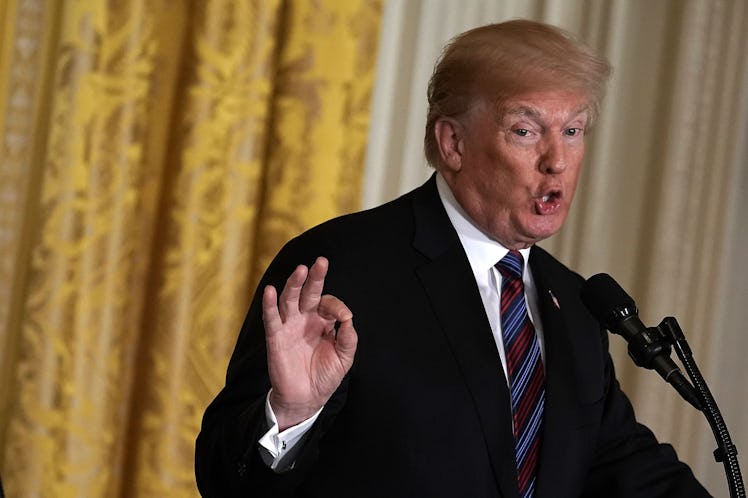
Trump Claims His Approval Rating Is Higher Than What Polls Say & We're Not Surprised
On Friday, April 6, President Donald Trump made an appearance on WABC's Bernie & Sid In The Morning, and had some confident statements to make about his popularity. On air, Trump claimed his approval ratings were in fact significantly higher than what polls have put them at, according to The Hill. This approval by Americans, he added, would translate to wins come election day.
On air, Trump cited a Rasmussen poll that showed Trump's approval rating had risen to 51 percent on April 4. "They say that it's 51, but add another 7 or 8 points to it," he said. "It's almost embarrassing for me to tell you because they don't want to talk about it, but when they get into the booth, they're going to vote for Trump. People know what's going on." This followed an April 4 tweet by the president also touting the Rasmussen findings.
The Rasmussen poll stands in contrast with FiveThirtyEight's average poll, updated Friday, that puts Trump's approval rating 12 points lower, at 40.2 percent, with a disapproval rating of 53.8 percent. Similarly, RealClearPolitics (RCP)'s average put Trump's approval rating at 41.5 percent and disapproval at 54.6 percent, giving him a 13-point net negative rating. A Morning Consult poll released Thursday also that found that Trump's approval rating was actually the lowest it had been since he took office. By Friday, his Rasmussen approval rating was back down to 47 percent, with a 52 percent disapproval rating.
It would be understandable if his latest claim gave some people déjà vu. His comments on his poll numbers are eerily reminiscent of his infamous crowd-size claims following his January 2017 inauguration. Despite photographs and expert assessments to the contrary, Trump and his administration continued to tout the size of his inaugural audience for months afterward. Former Press Secretary Sean Spicer later said in September he felt bad for making false statements about the inauguration. But that apology didn't seem to change much: Trump continued to show he has a habit of boasting about the turnout for his rallies and appearances; he spent part of his speech at Hurricane Harvey-battered Texas in August to point out the crowd size.
And on social media, some users weren't buying it.
There were memes and gifs aplenty, including this one of an exasperated toddler. (And folks with the Make Trump Tweet Again crayon font extension also have the benefit of seeing what the president's tweet-brag would look like in glorious, child's-handwriting scrawl.)
Trump's claim Friday is in keeping with a larger trend of overestimations. In fact, former White House Press Secretary Anthony Scaramucci made a similiar clam about Trump's approval numbers earlier this year. "Trump's approval ratings, like his pre-election poll numbers, are not an accurate representation of his true popularity," wrote Scaramucci in an op-ed for USA Today in January. "Media bias and sampling errors prevent the figures from having any credibility."
And in fact, Trump sort of has a point, more broadly, about the gaps in polling. As FiveThirtyEight's Nate Silver notes, polls do have margins of error — which basically mean that pollsters recognize that the numbers could be off by a certain number of percentage points — and most media reports miss that. For example, polls that ask about two candidates, or one candidate's approval rating, can have a margin of error as high as 8 percentage points, according to Silver. But but that goes both ways, plus or minus — so if Trump is referencing margin of error in claiming his approval rating is higher, then by the same token it could also be several points lower.
There's also polling error in things like response bias, given that only a tenth of the population responds to polls, and whether or not the polls were conducted with registered voters or just a sampling of adults. (The latter, per Silver, in theory tends to be more accurate.)
(Just for kicks: The Morning Consult poll was based on a survey of over 97,000 registered voters, while Rasmussen's was based on polling of 500 likely voters. So in terms of all-adults-versus-voters method, broadly speaking, they're apples to apples. But there is that one small detail that one poll was 195 times larger than the other, but who's counting.)
The more critical thing, Silver writes, is to understand and accurately report the margins of error of those polls. Polling averages may have lower margins of error (although take this with a grain of salt, too, Silver cautions, as polling errors tend to be off in the same direction) so may give us a better picture.
At the end of the day, even give or take a few percentage points, Trump's rating at the one-year mark put him at the most unpopular president in recent history, and the whole, he's still pretty far below what's normal for a sitting president. And both FiveThirtyEight and RCP's averages show Trump in the net negative.
It's not clear whether Trump in his Friday interview was referring to the 2016 presidential election, the 2020 election, where he'll be on the ballot again, or in a more symbolic sense, the 2018 midterm elections (in which many of his fellow party members will be judged in part on their with-or-against stances on Trump). On air, he pointed to his policy on immigration and international trade agreements as evidence that voters would be showing their approval at ballot boxes.
Either way, whether Trump's increased approval rating translates to election results down the road remains to a big if. And what polls we take into account — and how — makes a massive difference.